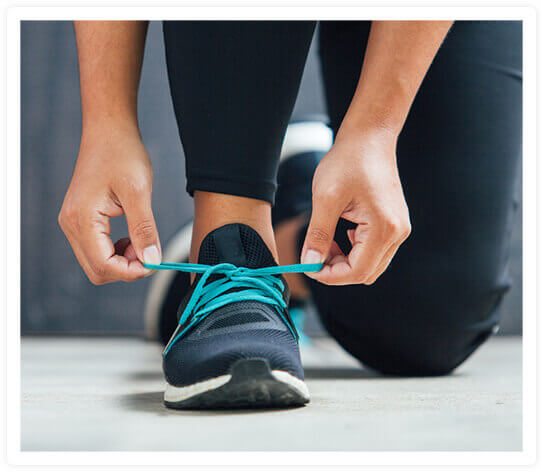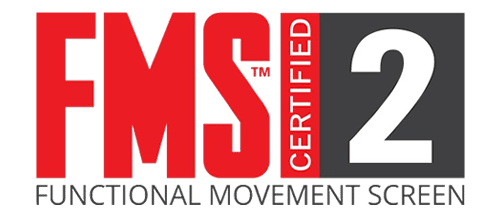Low Back Pain
Click on the white PLAY button below to start video.
The vertebrae in your lower back are larger than in any other part of your spine. Vertebrae are the series of bones that align to form your spine. The spinal section in your lower back is called the lumbar spine. The vertebrae are bigger in the lumber spine because they must support the weight of your upper body. They also withstand powerful forces from the lower back muscles. These strong muscles are attached to the lumbar vertebrae and are used during lifting, bending, and twisting activities.
Low back pain is very common. Muscle, ligament, nerve, and spine injuries are frequent causes of low back pain. Poor posture during movements and “wear and tear” can also cause low back pain. Degenerative diseases, such as arthritis, can cause the spinal structures to break down and put pressure on the spinal cord or nerves. Nerve pressure in the lumbar spine can cause symptoms to spread to the buttocks, legs, and feet. This is because the nerves that exit the spinal cord at the lumbar spine travel to these areas.
A medical examination is necessary to identify the cause of low back pain in order to determine the appropriate course of treatment. The majority of people with low back pain find relief with non-surgical treatments. However, for a small number of people with low back pain, symptoms progress or persist, and surgery can be an effective treatment.
Read more about Low Back Pain
Introduction
The vertebrae in your lower back are larger than in any other part of your spine. Vertebrae are the series of bones that align to form your spine. The spinal section in your lower back is called the lumbar spine. The vertebrae are bigger in the lumber spine because they must support the weight of your upper body. They also withstand powerful forces from the lower back muscles. These strong muscles are attached to the lumbar vertebrae and are used during lifting, bending, and twisting activities.
Low back pain is very common. Muscle, ligament, nerve, and spine injuries are frequent causes of low back pain. Poor posture during movements and “wear and tear” can also cause low back pain. Degenerative diseases, such as arthritis, can cause the spinal structures to break down and put pressure on the spinal cord or nerves. Nerve pressure in the lumbar spine can cause symptoms to spread to the buttocks, legs, and feet. This is because the nerves that exit the spinal cord at the lumbar spine travel to these areas.
A medical examination is necessary to identify the cause of low back pain in order to determine the appropriate course of treatment. The majority of people with low back pain find relief with non-surgical treatments. However, for a small number of people with low back pain, symptoms progress or persist, and surgery can be an effective treatment.
Anatomy
Your spinal cord and spinal nerves at the lumbar spine level send signals for sensation and movement between your brain and lower body muscles. Your spinal cord tapers near the first lumbar vertebra and forms a group of nerves called the cauda equina. The cauda equina is involved with regulating bowel and bladder functions.
Six intervertebral discs are located between the vertebrae in your lumbar spine. The discs are made up of strong connective tissue. Their tough outer layer is called the annulus fibrosus. Their gel-like center is called the nucleus pulposus. The discs and two small spinal facet joints connect one vertebra to the next. The discs and joints allow movement and provide stability. The discs also act as a shock-absorbing cushion to protect the lumbar vertebrae.
Causes
Compressed, pinched, or irritated spinal nerves can cause symptoms that extend from the low back, through the buttocks and legs, and down to the feet. This commonly occurs from structural changes in the spine. Bone spurs, abnormal bone overgrowths caused by Osteoarthritis, can grow in to the spinal canal or nerve root openings on the vertebrae. Bone spurs and some degenerative diseases can also contribute to a condition in which the spinal canal is narrowed, called Spinal Stenosis. Some degenerative diseases cause the spinal structures to thicken and extend into the spinal canal over time. The narrowed canal causes pressure on the spinal cord and nerves.
If the sciatic nerve is compressed or inflamed, a painful condition called Sciatica can result. The sciatic nerve extends from your lower back down to your foot. Trauma, spinal conditions, or medical conditions that irritate the sciatic nerve cause Sciatica. If the spinal nerves in the lower end of the lumbar spine are compressed, a condition called Cauda Equina Syndrome may result. Cauda Equina Syndrome can cause the loss of bladder and bowel control, along with leg pain, sensory deficits, and weakness.
Changes in the intervertebral discs can also cause low back pain. As we age, our discs lose water content. They become shorter and less flexible, a condition called Degenerative Disc Disease. Once the discs are injured, they do not have the blood supply to repair themselves and they deteriorate. Osteoarthritis and Rheumatoid Arthritis also cause the discs and vertebrae to deteriorate. Normally, the discs act as a cushion between the vertebrae. Without the disc cushioning effect, pain can occur. Without the protective disc, the spine can become structurally unstable and unable to tolerate stress. Degenerative Disc disease can also lead to a herniated disc.
A herniated disc occurs when the outer disc layer, the annulus, ruptures. When the inner content, the nucleus pulposus, comes out of the disc, it can cause pressure on the nerve tissue. When the inner contents of the disc come in contact with the spinal nerves, a chemical reaction occurs that causes irritation and swelling.
Some conditions can directly affect the integrity of the vertebrae. Osteoporosis is a medical condition that causes more bone calcium to be absorbed than is replaced. It contributes to vertebral fractures and deterioration. Spondylolisthesis is a condition that results when a weakened vertebrae slips out of alignment. Another condition, Spondylosis, results when Osteoarthritis or a fracture causes disc degeneration and the overgrowth of bone. Spondylosis causes stiff and painful joints.
Symptoms
Diagnosis
Your doctor may order imaging studies to identify the location and source of your low back pain. Your doctor will order X-rays to see the condition of the vertebrae in your lumbar spine and to identify fractures, misalignment, narrowed discs, or thickened facet joints. A Flexion and Extension X-ray can determine if there is instability between your vertebrae. For a Flexion and Extension X-ray, you will lean as far forward and then as far backward as you can. Sometimes doctors inject dye into the spinal column to enhance the X-ray images in a procedure called a myelogram. A myelogram can indicate if there are pinched nerves, herniated discs, bone spurs, or tumors.
A bone scan may be used to show fractures, tumors, infections, or arthritis. A bone scan requires that you receive a small harmless injection of a radioactive substance several hours before your test. The substance collects in your bones in areas where the vertebrae are breaking down or repairing bone.
Your doctor may also order Computed Tomography (CT) scans, a Discogram, or Magnetic Resonance Imaging (MRI) scans to get a better view of your spinal structures. CT scans provide a view in layers, like the slices that make up a loaf of bread. The CT scan shows the shape and size of your spinal canal and the structures in and around it. A CT scan is useful for determining which disc is damaged. Your doctor may inject dye into the disc area to enhance the CT images in a procedure called a Discogram. A Discogram provides a view of the internal structure of a disc and can help to identify if it is a source of pain. The MRI scan is very sensitive. It provides the most detailed images of the discs, ligaments, spinal cord, nerve roots, or tumors. X-rays, myelograms, bone scans, CT scans, and MRI scans are painless procedures and simply require that you remain motionless while a camera takes the pictures.
Nerve conduction studies reveal how the lumbar spinal nerves are working. Doctors commonly use a Nerve Conduction Velocity (NCV) test. During the study, your spinal nerve is stimulated in one place and the amount of time it takes for the message or impulse to travel to a second place is measured. The place where the impulse travels slowly at is where the nerve is compressed. Your doctor will place sticky patches with electrodes on your skin that covers the spinal nerve. The NCV test may feel uncomfortable, but only during the time that the test is conducted.
An Electromyography (EMG) test is often done at the same time as the NCV test. An EMG measures the impulses in muscles to identify atrophy or decay. Healthy muscles need impulses to perform movements. Your doctor will place fine needles through your skin and into the muscles that the spinal nerve controls. Your doctor will be able to determine the amount of impulses conducted when you contract your muscles. The EMG may be uncomfortable, and your muscles may remain a bit sore following the test.
Surgery
A Laminectomy is the most common surgery for Spinal Stenosis. This surgery is also used for relieving the symptoms of Sciatica caused by a disc herniation. The goal of a Laminectomy is to relieve the pressure on the spinal cord and nerves by enlarging the spinal canal where it has narrowed. To do so, the surgeon removes all or part of the lamina on the affected vertebrae. If all of the lamina is removed, the procedure is called a Laminectomy. A Laminotomy involves removing only part of the lamina.
A Discectomy is a type of surgery used to remove the part of a disc or fragments of bone that are putting pressure on the spinal cord or nerves. A Discectomy may be required if a herniated disc is pressing directly on a nerve or the spinal cord and causing considerable pain. In select cases, a Discectomy can be performed arthroscopically. Arthroscopic surgery uses small specialized tools and a small incision. It can be performed under local anesthesia and has a shorter recovery time than traditional surgery. However, an Open Discectomy is the type of surgery most frequently used for a lumbar herniated disc. Commonly, this is performed through a small incision and with the use of a microscope. This is called a microdiscectony. In some cases, a Discectomy is performed in combination with a Spinal Fusion.
Spinal Fusion is the type of surgery most frequently used for Degenerative Disc Disease. Spinal Fusion involves fusing or securing the vertebrae together after removing the degenerative or herniated disc. The purpose of Spinal Fusion is to stop motion between spine segments and relieve pain caused by this movement.
There are a variety of techniques for Spinal Fusion surgery. The surgeon may approach the spine from the front or back. There are also many methods used for fusing the bone together. The surgeon may use a bone graft or interbody fusion cage and special surgical hardware. A bone graft consists of small strips of bone taken from your hip during surgery. The bone grafts are placed in the empty disc space between the vertebrae. An interbody fusion cage is a small container that is filled with bone shavings and placed between the vertebrae. The bone grafts are surgically secured to the spinal column with surgical hardware, such as screws and rods. The surgical hardware secures the vertebrae together and allows the bone grafts to heal, fusing together the vertebrae.
Treatment
You may wear a back support at the onset of pain for symptom relief. Over-the-counter medication or prescription medication may be used to reduce your pain. If your symptoms do not improve significantly, your doctor may inject your back with pain relieving medication.
Physical therapists can provide treatments to reduce you pain, and muscle spasms. They will show you exercises to gently stretch and strengthen your back and abdominal muscles. Physical therapists can use modalities, such as ultrasound and heat packs, to ease discomfort. Aquatic therapy can be helpful for low back pain. The heated water environment may help reduce pain and provide support while you exercise. Your therapists will also show you proper postures or body mechanics to use during movements, such as how to position your back when lifting. The use of proper body mechanics can help to prevent further injury. You physical therapy treatment plan may also include work simulation activities to help you get back to work.
Recovery
Prevention

Copyright © - iHealthSpot Interactive - www.iHealthSpot.com
This information is intended for educational and informational purposes only. It should not be used in place of an individual consultation or examination or replace the advice of your health care professional and should not be relied upon to determine diagnosis or course of treatment.
The iHealthSpot patient education library was written collaboratively by the iHealthSpot editorial team which includes Senior Medical Authors Dr. Mary Car-Blanchard, OTD/OTR/L and Valerie K. Clark, and the following editorial advisors: Steve Meadows, MD, Ernie F. Soto, DDS, Ronald J. Glatzer, MD, Jonathan Rosenberg, MD, Christopher M. Nolte, MD, David Applebaum, MD, Jonathan M. Tarrash, MD, and Paula Soto, RN/BSN. This content complies with the HONcode standard for trustworthy health information. The library commenced development on September 1, 2005 with the latest update/addition on February 16, 2022. For information on iHealthSpot’s other services including medical website design, visit www.iHealthSpot.com.






